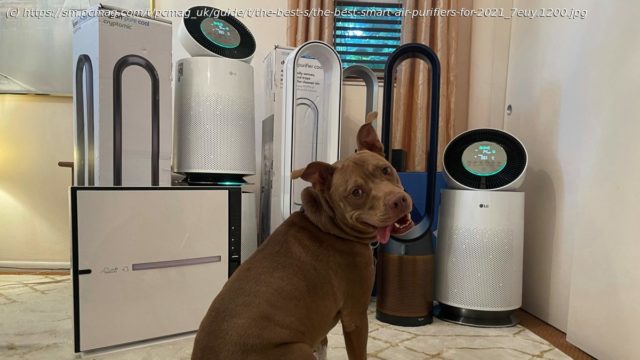Smart air purifiers can help you keep a close eye on your indoor air quality and breathe a little easier. From HEPA filtration to ionic technology, we help you understand your options and select the best connected air purifier for your needs and budget.
Between allergies, COVID-19, and wildfires, there are plenty of reasons to be concerned about the quality of the air you breathe. With these issues more prominent than ever, it’s no wonder that demand for air purifiers is on the rise. A high-quality air purifier can remove bacteria, dust, industrial emissions, mold, odor, pet dander, pollen, viruses, and other contaminants from the air. But not all air purifiers are created equal, and with so many compelling models on the market, it can be tough to narrow down your options. Over the past year, we here at PCMag have made it a priority to test a wide range of smart air purifiers to help you select the best one for your needs and budget. (We’ve even tested the Razer Zephyr, a “wearable air purifier” that’s really just a high-tech face mask.) On a personal note, my interest in air purifiers began in pre-COVID times, shortly after I adopted my pitbull Bradley in the fall of 2019. I’m allergic to dogs, but his cute face and playful personality easily won me over. It wasn’t long after adopting him that my allergies turned into asthma. Desperate for relief, I bought a refurbished Dyson Pure Cool Link TP02 on eBay during a Black Friday sale. My refurbished unit worked like new, and while I can’t say that it alone cured my asthma and allergies, it has helped lessen my symptoms (along with medicine and daily vacuuming). My dog, Bradley, surrounded by air purifiers I’m reviewing Since then, I’ve acquired an army of smart air purifiers from various brands to test and review. I still take Xyzal allergy medication daily, but haven’t had an asthma flare-up or had to use my Albuterol inhaler in more than a year. I tell you this as a testament to the power air purifiers (as well as robot vacuums and modern medicine). If you’re looking to improve your indoor air quality, a good purifier is a must. But before investing in one, read on for some important factors to consider. What Makes an Air Purifier Smart? Most air purifiers (not just smart ones) typically have sensors that measure the density of various airborne pollutants such as nitrogen dioxide (NO2, a toxic gas primarily produced by car exhausts and power plants), PM2.5 (particulate matter smaller than 2.5 microns in size, including industrial emissions and tobacco smoke), PM10 (particulate matter up to 10 microns, including dust, mold, and pollen), and VOC (volatile organic compounds, or potentially harmful gases from things like cleaning products and paint). LG ThinQ app Smart air purifiers typically feature Wi-Fi for phone and/or voice control, and to collect information on the pollutants above, sending it to a companion app where you can monitor your home’s air quality. Some apps offer graphs of your air quality over time. Dyson breaks it down by pollutant, showing graphs for each one. Dyson Link app Most smart air purifiers feature an auto mode, which will automatically adjust the machine’s fan speed based on the level of pollution detected. They also typically let you set up an air purifying schedule, so the machine automatically turns on and off at your specified times. Some models feature Amazon Alexa, Google Assistant, and Apple Siri support, so you can control them with voice commands. Common Contaminants and Their Health Effects Some sources of indoor air pollution are obvious, like cigarette smoke, household cleaning products, and pet dander. Others are less so. The US Environmental Protection Agency (EPA) says that “thousands” of products—including air fresheners, dry-cleaned clothing, and office equipment like copiers and printers—emit VOCs, which can lead to a long list of health effects ranging from headaches to cancer. Moreover, concentrations of VOCs are typically much higher indoors than outdoors. Sharp FXJ80UW Anything that causes smoke—such as cooking, burning candles or incense, or lighting up a fireplace—can lead to elevated concentrations of particulate matter. The EPA says PM10 and smaller can “get deep into your lungs” and, in some cases, your bloodstream. Inhalable particles, especially PM2.5, which is 30 times smaller than the average human hair, may pose a greater risk to those with heart and lung diseases such as asthma, chronic obstructive pulmonary disease (COPD), congestive heart failure, and coronary artery disease. Most smart air purifiers detect PM10 and PM2.5, but LG’s $1,299 PuriCare 360 is the only model on this list that reports the density of PM1.0 (particulate matter 1 micron or smaller). LG PuriCare 360 Humidifiers can help relieve cracked lips and dry skin, but if you’re not careful to use distilled water and clean them often, they can provide a fertile breeding ground for bacteria and mold, which is then pumped into your air.






